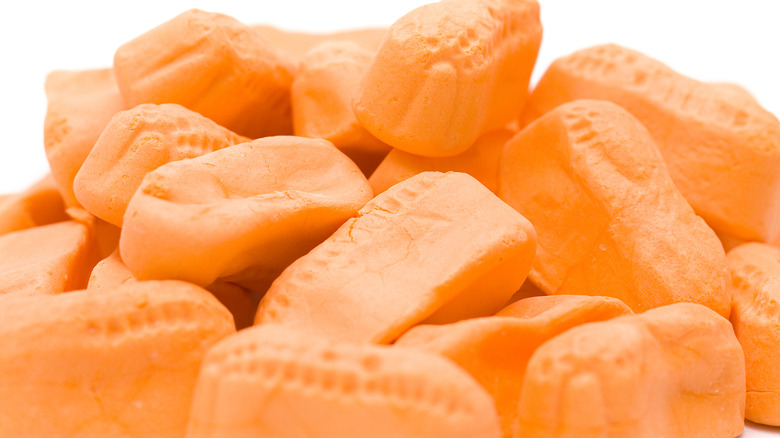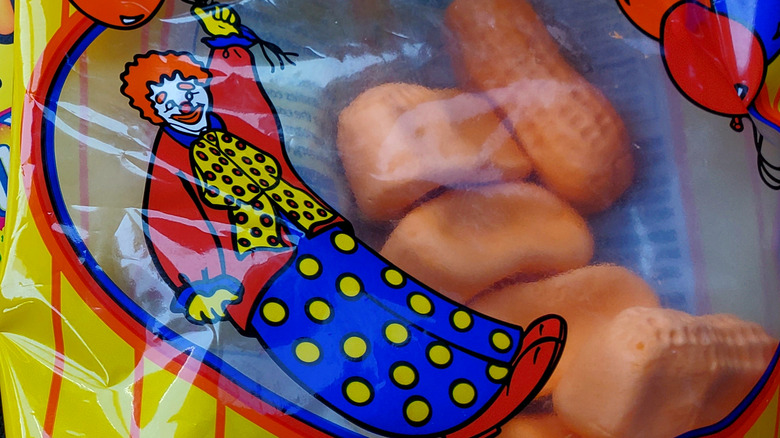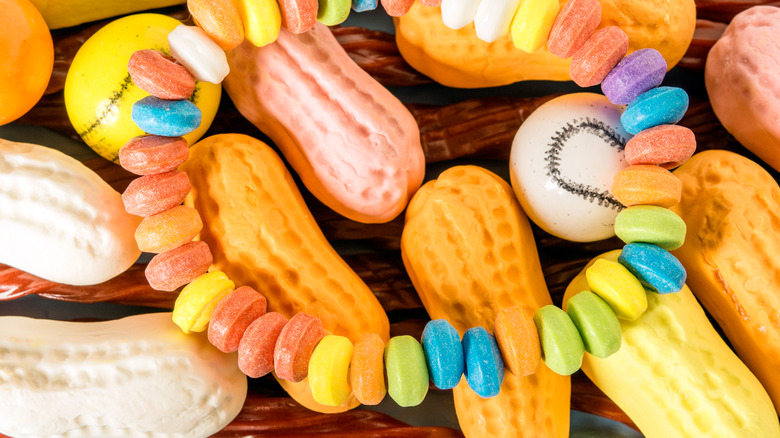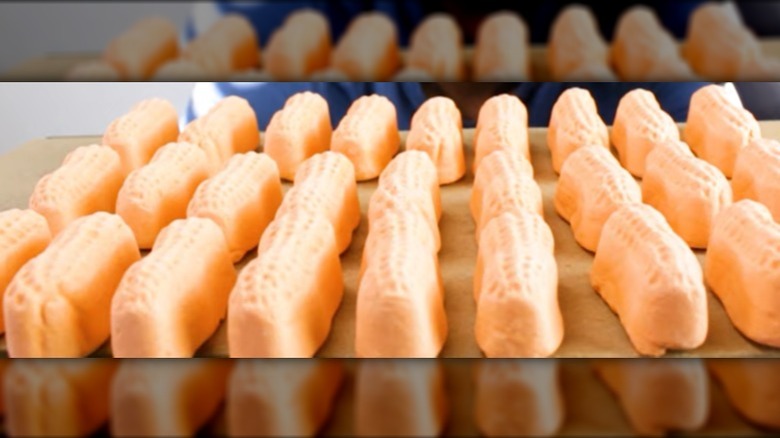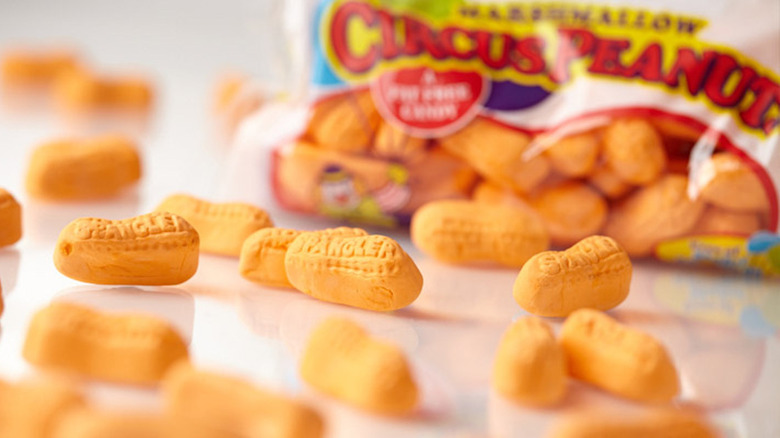What Are Circus Peanuts And How Are They Actually Made?
It's safe to say that circus peanuts fall in the same category as candy corn, black licorice, and Peeps — as all of these sweets have been deemed polarizing to candy eaters everywhere. You either love them, or you can't stand the mere thought of their texture and taste. Often topping the list of the worst candies ever made are these circus peanuts, which have miraculously maintained a devoted fan base since their debut in the 19th century (per CandyFavorites.com).
Circus peanuts, despite their name, taste absolutely nothing like peanuts. In fact, they contain zero traces of any type of nut at all. So, what exactly are these squishy, legume-shaped wonders made of, and how have they seemingly withstood the test of time in the confectionery world? Whether you're a die-hard fan of circus peanuts or would rather eat literally anything else, keep reading to learn the story of this legendary candy.
What are circus peanuts?
To give the most basic definition, circus peanuts are peanut-shaped marshmallow candies with a soft, spongy, and slightly airy texture, and a peachy-orange hue. Circus peanuts were invented in the 1800s and are considered one of the original "penny candies." As their name implies, penny candies cost just one cent apiece. They were often wrapped individually and sold at soda fountains, candy shops, and five-and-dimes (via CandyFavorites.com). Up until the 1940s, circus peanuts were a seasonal product only available in the spring, but with the invention of polyethylene film, they could be sold in bulk and enjoyed year-round (per Eater). Spangler Candy makes about 32,000 pounds of circus peanuts daily and is one of the few companies still manufacturing the candy today.
You might be wondering about the "circus" part of the candy's name. One theory is that circus peanuts were popular among traveling circuses, where vendors also sold salted peanuts and other candy. Steve Almond, who wrote a chronicle of candy making in America called "Candyfreak: A Journey through the Chocolate Underbelly of America," describes circus peanuts as "a mixture of fascination and disgust. It's a completely baffling candy" (via CandyFavorites.com).
What do circus peanuts taste like?
Shocking to no one, circus peanuts have nothing in common with the peanuts you'd munch on during a ball game. There is no similarity in flavor, color, aroma, or texture. Classic circus peanuts possess an artificial banana flavor, which you might think of as odd. According to celebrity chef and television personality Andrew Zimmern, it may have been an unexpected banana oil incident that determined the flavor of this candy (via Eater). Regardless of whether that claim is true, for many, the flavor choice remains bizarre.
Not bananas over bananas? In addition to the traditional variety, you can also enjoy rainbow circus peanuts! This assorted, multicolored variety pack features the same peanut-shaped marshmallows in four different pastel colors and flavors: orange, pink, yellow, and white. The orange peanuts, of course, have their usual banana flavor. The pink peanuts, however, taste like cherry, while the yellow peanuts are lemon-flavored, and the white peanuts have notes of vanilla (via candy nation).
How are circus peanuts made?
Spangler Candy, the confectionery known for Dum-Dums, has been producing circus peanuts since the 1930s in northwest Ohio. Circus peanuts are technically marshmallows as the fundamental recipe includes sugar, high-fructose corn syrup, gelatin, and artificial colors and flavors. However, unlike your traditional fluffy white marshmallows essential for making s'mores, circus peanuts have a very different look, feel, and taste. Since circus peanuts contain high amounts of corn syrup, they have a moist consistency when they're fresh but quickly become stale when left out. They also have a subtly grainy texture in contrast to soft, pillowy, gummy marshmallows (via CANDYBLOG).
The process by which circus peanuts are made is fairly complex and timely — taking over a day from start to finish. First, a mixture of sugar and water is pumped into a vessel. Then pectin, a soluble fiber found in fruits and vegetables, is added to create a soft texture. Once the corn syrup is incorporated into the batch, it gets pumped into a large cooling tank, in which the gelatin, color, flavor, and powdered sugar are added. The composition travels through an aerator where it's rapidly whipped around to create circus peanuts' fluffiness. The batch is poured into a starch-coated tray with individual peanut pod-shaped molds. After drying for a full 24 hours, the candies are given an "air bath" to remove any excess starch. Finally, the finished product is conveyed through metal detectors and then packaged up (per Spangler Candy).
What are the nutritional facts of circus peanuts?
Circus peanuts have very little nutritional value. They are, after all, candy. The recipe for circus peanuts, as described above, includes sugar, corn syrup, gelatin, pectin, artificial flavor, and added colors yellow 6, yellow 5, and red 40. The suggested serving size is five peanuts (if you can force yourself to eat even that many), amounting to 147 calories. Circus peanuts contain zero grams of fat, trans fat, sodium, and protein. They also carry 38 grams of carbohydrates and 35 grams of sugar per serving. On the bright side for those avoiding gluten, circus peanuts are certified gluten-free (per Spangler Candy).
Circus peanuts are a surprisingly ubiquitous find. If you look hard enough, you can get them in most candy shops and convenience stores across the country. The four main companies that produce circus peanuts today are Spangler Candy, Melster Candies, Brach's, and Farley's & Sathers (via CANDYBLOG).
